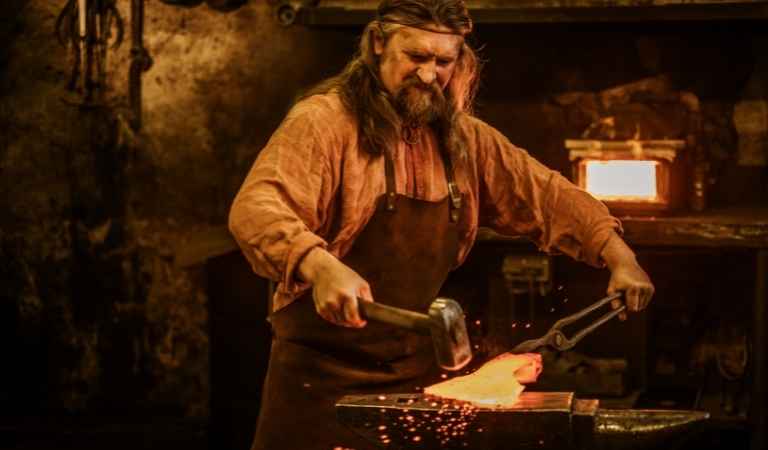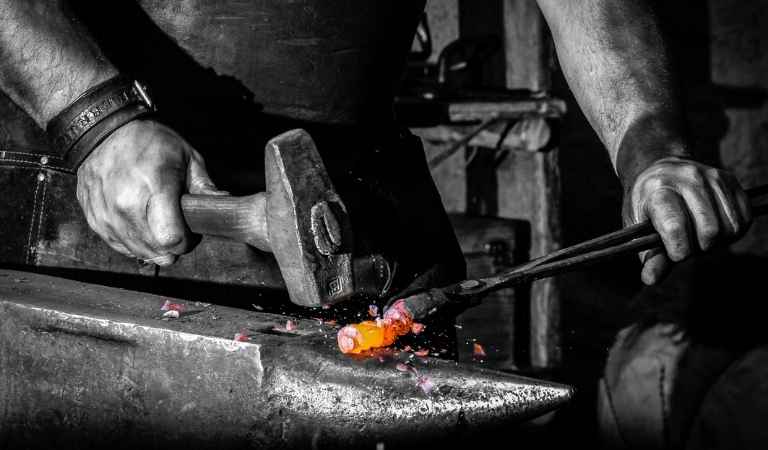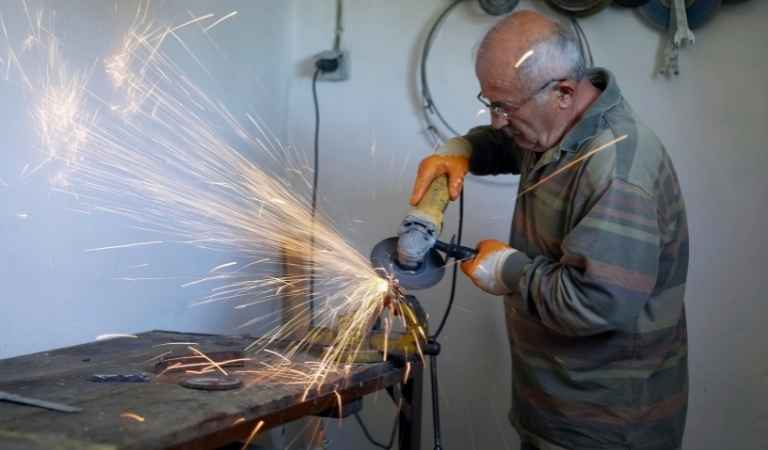Blacksmiths have been crafting tools and weapons for centuries. They are the backbone of many civilizations, supplying their armies with everything from swords to horseshoes.
Nowadays, blacksmiths work in a variety of settings where they may be called on to do anything from repairing metal objects or creating sculptures that require welding together pieces of metal.
Blacksmithing is an art form that has survived through millennia and is only now starting to find its way into the mainstream again. In this blog post, we will discuss what a blacksmith does and the skillset a professional blacksmith must have!

Why is a Blacksmith Called Blacksmith?
A blacksmith is a person who works with metal. A blacksmith can be someone who forges or creates, metal items such as farm tools, weapons, or even sculptures.
The origins of the word "blacksmith" date back to the fifteenth century when it was derived from the two words "black metal" and "smite." The word "smite" or "smythe" means to hit something with force. Blacksmiths use this skill every day by forging pieces of iron that are heated until they're red-hot using an open flame.
Why Blacksmith Use Heat?
Blacksmiths use heat to change the properties of the metal that they're working with. Metal is an incredibly strong material but it's also heavy and hard, which makes it difficult for a blacksmith to work on pieces by hand. That's why they have resorted to using fire as their main tool in "working" or shaping metal.
When metal gets hot, it becomes pliable and easier to work with. Blacksmiths use this technique because they can change the shape of metal by heating them up until they're red-hot, then shaping them into a new form.
What are the Duties of a Blacksmith?
What blacksmith do vary depending on what is needed by their community; some blacksmiths may be called upon to create sculptures that require welding together pieces of metal while others might spend time repairing metal objects or creating horseshoes for horses. Here are some of the common tasks that blacksmiths perform-
Blacksmiths shape metals
There are many different types of metal that blacksmiths work with in order to make the best weapons and tools for their community. These include steel, aluminum, brass, and bronze; some specialize only in one type while others might spend time mastering all of them.
When blacksmiths make a new sword, they actually create the metal from raw materials and then forge it into shape using fire or hammers; this process is called smithing. They also heat up metals to different temperatures in order to give their project more strength and durability when required.

Blacksmiths are skilled craftsmen
Even if a blacksmith is not creating something from scratch, they will still need to be skilled in shaping and bending the metal into the desired shape using hammers or other tools; this process is called forging. They also spend time working on small details of their project like smoothing out rough edges with a grinder before it's finished.
Blacksmiths take risks
The blacksmith will spend a lot of time with their hands on the metal, which can be very dangerous since they are dealing with fire all day long; this is why they need to wear gloves to protect them from burns or blisters.
In addition, some may work in tight spaces where it's difficult for them to stretch out their legs without hitting something so they'll need to stand most of the day while using just one foot at a time. This job requires balance and agility!
Must-Have Skills For Blacksmithing
Some people might think that blacksmithing involves just pounding metal while red hot until something useful appears but, in reality, it's a lot more complicated than that.
This job requires various practical skills which you cannot learn from reading books or watching videos online as they need to be acquired by doing rather than being taught through other methods. So, these are some of the skills necessary for professionals:
Understand Metal Well
The blacksmith needs to know the qualities of different types of metal, how they behave when heated and cooled. This skill is required to be able to work with metal.
He needs to understand how metal can be joined together by processes like welding and brazing in order for them to make the things that they make, which are often large pieces of equipment or buildings. This skill is also helpful when making smaller items such as tools or decorative objects from scrap metals.
The person needs to understand the use cases of the final outcome and plan out the required metal so that the tool can be utilized up to its potential. So, detailed and clear knowledge about metal is required for a blacksmith.
Using Blacksmithing Tools
Blacksmiths need to be able to use a forge well, understand the purpose of tools such as hammers, anvils, forge, or tongs. They must also have experience with things like power equipment or grinding wheels.
A lot of modern-day blacksmiths use hydraulic pressing tools instead of forging hammers because it takes less physical effort on their part while still being just as effective at shaping metals into usable products. The skilled smith should know how best to operate these machines and the ways in which different power tools can be used in order to create different types of metal products.

In addition, the smith should understand how to use equipment like a cutting torch or MIG welder so that they are able to make things on their own without having someone else do it for them.
Practical Skills For Blacksmithing
Blacksmithing requires various practical skills that can be acquired only by doing. Blacksmiths need to have manual dexterity and hand strength because they do not use power tools for every part of their work like machine operators would.
They also often use their hands to hold materials while manipulating them with other parts of their body. This skill is necessary in order to maneuver metal into shapes without breaking it which means that blacksmithing requires more than just physical labor but also creativity as well as technical know-how about how metals behave when heated and cooled.
Creativity And Craftsmanship
The person should have an imagination in terms of what he want to create and the ways in which that can be achieved, as well as having good craftsmanship. For example, not just being able to weld two pieces of metal together but also knowing how to do it properly so that there is no risk of either piece breaking apart afterward or other types of damage.
A blacksmith needs skills like using a cutting torch for making intricate designs into metals because this requires more than just physical labor-it takes skillful precision with materials like solder and gas torches. A lot of blacksmiths make their own artwork using these tools by creating sculptures out of iron while others paint onto them after heating them up first.
Ability to Do Repetitive Works
Blacksmiths should be able to do repetitive works without any problems - things like hammering metal for hours and using a grinder. They also need to know how to make themselves comfortable while doing these things because it is not easy on the body, mind, or even the eyesight which can often get strained when working with heated metals over time.
So, you have to be dedicated enough in order to withstand such conditions if you want this job but at the same time, you should be careful about following safety guidelines and wearing protective gear so that the experience does not end up harming you instead of helping.
And since blacksmiths work closely with fire then they always risk getting burned by it or inhaling too many chemicals from whatever material they are working on.
So, this is another important skill that the person needs for their profession-being able to do work safely and not be afraid of things like injury or death because it can happen at any moment without us knowing beforehand.
Drawing and Upsetting
A professional should have drawing skills and be able to upset the metal-basically, being able to make thick pieces of metal into thinner ones or vice versa. They also need a certain level of strength in order for it not to break on them while they are doing it so this is one skill that many people might be lacking but which can be learned with time and consistency.
Punching Metal
The person needs to know how to punch metal - basically, making small holes into it with a hammer. This is one skill that many people might not be able to do because they do not have the patience for doing repetitive actions but it can also be learned if you are willing enough and persistent in your endeavors.
So, this requires both mental strengths as well as physical labor since punching often means that you will need stamina and endurance so your mind does not give up from being bored or tired of the activity while at the same time having muscle coordination on the side so you don't end up breaking any parts of themselves in the process.
Maintain A Clean Work Area
Blasting off particles on work surfaces in an area where molten metal will drip down onto it isn't safe for anyone - worker or bystander - and there's no point risking life and limb for aesthetics; cleanliness is important.
So, if you want to become a blacksmith, you should try to learn these skills.
Can I Blacksmith in My Backyard?
There are so many reasons why you would want to blacksmith in your backyard. For one, it’s a fantastic way for people of all ages and skill levels to get started with this stimulating hobby-crafting activity that has been around since the days when metal was first being forged into weapons.
However, whether you can blacksmith in your backyard or not depends on the local laws. Some regions have strict laws banning blacksmithing in residential areas whereas some allow you to do it the right way. That's why you need to check the local laws before starting to do things in your backyard.
Is a blacksmith a welder?
No, blacksmiths are not regular welders but they may need to weld things sometimes.
A blacksmith’s task is to forge metal pieces by heating, shaping, and hammering the hot metal with a series of hand tools such as anvils, hammers, or tongs. In the process of making the fines of metal pieces, blacksmiths sometimes require welding machines as well. But they are not regular welders.
How do blacksmiths cool the metal?
The blacksmith cools the metal by dipping it back into water. The heat in the metal is taken away by this process.
Blacksmiths use metal tongs to pick up the heated iron and move it above a fire, where they then shape or forge the hot metal in order to make their desired product.
The blacksmith continuously moves back and forth between dipping the metal into water and heating it over an open flame until he forms his final piece of work.
How much does it cost to start blacksmithing?
The cost to start blacksmithing can vary. You'll need a blacksmith forge, anvil and some other tools at the workbench and possibly welding chain depending on what you're trying to do with it. If you already have these items then this could be free or very low-cost for you.
Leave a Reply